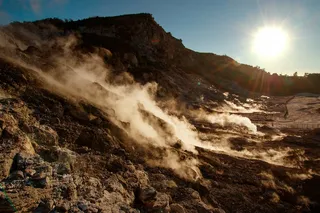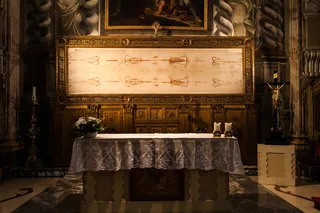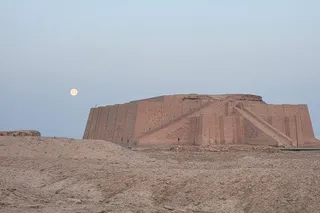In early summer 2007, a Utah river guide named Steve Currey planned to head an expedition the likes of which we don't often see nowadays.
In the 21st century, our planet (or at least it's surface) feels trodden, long since mapped, and thereby stripped of its greatest mysteries.
Surely, we would already know if there were a gaping hole at the North Pole that leads to a lush inner world. Yet Currey, a champion of the centuries-old "hollow earth" theory, chartered a Russian nuclear-powered icebreaker on the premise that we don't know.
Championing the Hollow Earth Theory
Between June 26 and July 19, Steve Currey intended to sail the North Pole from Murmansk to the precise coordinates at which he expected to find the entrance to interior Earth.
For $20,000 apiece, 100 passengers were invited to join "this historic voyage." However, a year before his scheduled departure, Currey died suddenly of brain cancer, and the trip was canceled.
In the years since, an engineer named Brooks Agnew has taken up the mantle (pun intended) of offbeat Arctic exploration. The North Pole Inner Earth Expedition is ostensibly still afoot, though logistical details are scarce.
In a 2022 interview, the new leader framed his quest as a dispassionate, empirical endeavor. "What's the truth? It's difficult to tell," he says. "That's one of the reasons we want to do this expedition. Let's prove or disprove the biggest myth in human history."
Ancient Hollow Earth Beliefs
Agnew is right about one thing: the mythological ubiquity of subterranean realms. Hades to the Greeks, Duat to the Egyptians, Hell to the Christians, and so on.
Of course, any mainstream geologist will tell you that science has already disproven these ancient yarns — it's not at all "difficult to tell." With perhaps a passing nod to folkloric whimsy, they will explain that the Earth consists of a thin crust, a rocky but flowing mantle that drives tectonic activity, an outer core of molten liquid and an inner core of solid iron and nickel.
That's the expert consensus, grounded in seismic data from earthquake monitoring and other lines of firm evidence. But there was a time when brilliant thinkers, lacking the advanced instruments of modern researchers, found a hollow Earth not just possible but plausible.
Read More: Drilling Deep: How Far Have We Gone Under Earth's Crust?
Edmund Halley's Groundbreaking Hypothesis
Perhaps the most eminent hypothesis, claimed by today's believers, comes from the English astronomer Edmund Halley.
In 1686, trying to explain shifts in the planet's magnetic field over time, he suggested that below the surface lie three concentric shells, each with poles that rotate independently and interfere with above-ground compass readings. He thought each of these nested layers was likely inhabited, their life forms supported by some unknown light source.
Halley's genius — rather than firm evidence — imbued the theory with some degree of credibility. Since then, as David Standish explains in Hollow Earth, it has enjoyed a long and vibrant history, with later generations enlarging its scope. "Right down to the present," he writes, "the idea has been used again and again, changing and evolving in ways that suit the needs and concerns of each succeeding time."
The Search for Symmes Holes
It was one thing for Halley to speculate on the bowels of the Earth and quite another for an eccentric American trader named John Cleves Symmes, Jr., to seek them out. In 1818, he published Circular No. 1, both an account of his views on the subject and a vow of action. "I pledge my life in support of this truth and am ready to explore the hollow," he wrote, "if the world will support and aid me in the undertaking."
Such an undertaking seemed reasonable in light of his new contribution to hollow-Earth theory. While Halley never posited a bridge to the nether regions, Symmes insisted on the existence of openings at the north and south poles, granting access to a "warm and rich land, stocked with thrifty vegetables and animals if not men." In his telling, these "Symmes holes" spanned thousands of miles and curved so gently you could sail into them without noticing the transition.
His evangelism mostly met with ridicule, and his dreams of a government-funded expedition went unrealized. Symmes never did make the trek north. But his ideas blossomed throughout the 19th century in the early science-fiction works of writers like Jules Verne and Edgar Allen Poe, who in turn inspired future believers.
Read More: How We Know What’s Deep Inside the Earth, Despite Never Traveling There
Admiral Byrd's Expedition
These days, another pillar of the hollow Earth narrative — though he may not have embraced this reputation — is Admiral Richard Byrd, an American explorer who led the first flights over both poles in the 1920s (and supposedly one of the few surface-dwellers to glimpse the secret at our planet's heart).
Despite numerous visits to the northern and southern extremities, Byrd never once mentioned an opening. Nevertheless, to substantiate their claims, hollow Earthers routinely cite this enigmatic remark from 1947: "I'd like to see that land beyond the Pole. That area beyond the Pole is the center of the Great Unknown." Talk about a gold mine of open interpretation.
Hollow Earth Literature
The closest thing this fringe movement has to scripture is a book titled The Hollow Earth, and subtitled "The Greatest Geographical Discovery in History Made by Admiral Richard E. Byrd in the Mysterious Land Beyond the Poles — The True Origin of the Flying Saucers."
Published in 1962 by Raymond Bernard, a man devoted to various strains of esoterica, it reflects many of the strangest notions piled upon Halley's old idea of an onion Earth.
Certain as he was of our advanced alien neighbors in the basement, Bernard thought we might look to them for guidance and salvation in this era of mutually assured destruction. "Perhaps this elder wiser race may save us from our doom," he writes, "preventing a future nuclear war and enabling us to establish a New Age on Earth, an age of permanent peace."
Read More: Earth Has Been Hiding a Fifth Layer in Its Inner Core
From Vikings to Lost Tribes: The Quest Continues
Bernard's is a particularly utopian vision of hollow Earth, but it's just one of many. Some imagine it to be inhabited by Vikings, dinosaurs, escaped Nazi scientists or the Lost Tribes of Israel.
The still-active web page for Currey's 2007 voyage provides an especially detailed picture and itinerary. First, they planned to find "the River Hiddekel and sail up the river to the City of Jehu." From there, "expedition members could take an inner earth monorail train to visit the lost Garden of Eden located under America on the highest mountain plateau of the Inner Continent." If they got lucky, perhaps they could "visit the palace of the King of the Inner World." Quite the bang for your 20,000 bucks.
Rodney Cluff, a prominent member of Agnew's long-gestating expedition, has never harbored any doubts about what they would encounter upon reaching the pole. "I've come up with substantial evidence from scripture, from history, from science, that our Earth is indeed hollow," he said in a 2022 interview. Cluff believes it to be the site of both Heaven and Hell.
Earth's core, as inaccessible as the Sun for all practical purposes, has always made a handy repository for our wildest fantasies. Besides these riveting tales, the reality — 8,000 solid miles of lifeless, churning minerals — may seem rather dull.
The Hollow Earth Conspiracy Stands Strong
In the refutations of science, self-respecting hollow-Earthers will hear only a pitiable close-mindedness. But anyone inclined to spend a very expensive vacation searching for paradise in a frozen wasteland might consider the words of Bucknell University geologist Duane Griffin.
"There is no empirical evidence for an intraplanetary void," he writes, "a great deal of evidence to the contrary, and the Hollow Earth model explains nothing about the physical world that cannot be explained more simply and completely by other means."
Read More: Earth’s Inner Core Is Growing Lopsided















